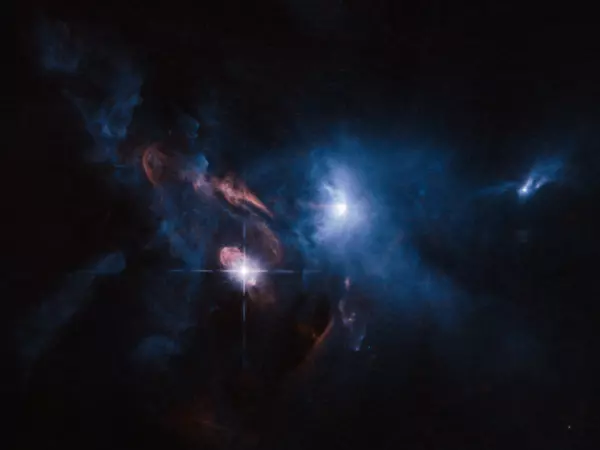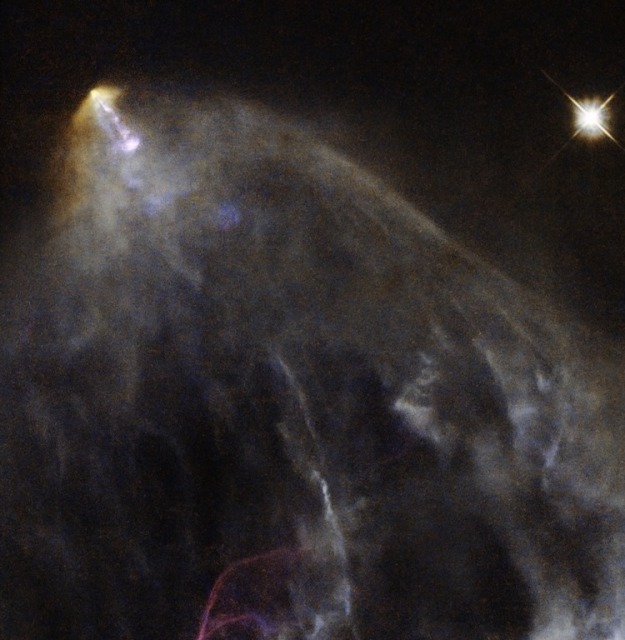XZ Tauri is a binary star located in Taurus constellation. It lies at an approximate distance of 450 light years from Earth.
XZ Tauri is located in the Taurus-Auriga molecular cloud, one of the closest star forming regions to Earth. The XZ Tauri system consists of two pre-main sequence stars classified as T Tauri-type variables that orbit each other from a distance of about 6 billion kilometres, or roughly the distance from the Sun to Pluto.
The two components are very young stars. They are located in the north-eastern portion of a dark cloud designated LDN 1551. One of the stars is believed to be a binary itself, which makes XZ Tauri a triple star system.
A superflare was observed in the XZ Tauri system in 2000, when time-lapse videos made from a series of Hubble photos revealed jets of gas moving through space at a speed greater than 300,000 miles (540,000 kilometres) per hour.
The two star systems captured by Hubble, XZ Tauri and HH 30, are both believed to be less than a million years old. HH 30 is a Herbig-Haro object, a streak of hot gas blown into space by a newly formed star. HH 30 is associated with V1213, a variable star in Taurus.

The NASA/ESA Hubble Space Telescope has snapped a striking view of a multiple star system called XZ Tauri, its neighbour HL Tauri and several nearby young stellar objects. XZ Tauri is blowing a hot bubble of gas into the surrounding space, which is filled with bright and beautiful clumps that are emitting strong winds and jets. These objects illuminate the region, creating a truly dramatic scene. Image: ESA/Hubble & NASA, Acknowledgement: Judy Schmidt
XZ Tauri is emitting a bubble of hot gas that is rapidly expanding and cooling off as it reaches a postshock cooling zone. After expanding for about 30 years, the hot bubble now spans an area of almost 60 billion miles (96 billion kilometres), about 15 times the distance between the binary pair. The estimated temperature of the bubble is more than 17,500 degrees Fahrenheit (9,700 degrees Celsius).
The nebulosity surrounding XZ Tauri is shaped by shock waves from other newly formed stars in the region. These stars rotate rapidly and blast off huge amounts of material into space.

This image shows an object known as HH 151, a bright jet of glowing material trailed by an intricate, orange-hued plume of gas and dust. It is located some 460 light-years away in the constellation of Taurus (The Bull), near to the young, tumultuous star HL Tau. In the first few hundred thousand years of life, new stars like HL Tau pull in material that falls towards them from the surrounding space. This material forms a hot disc that swirls around the coalescing body, launching narrow trails of material from its poles. These jets hurl outwards out at speeds of several hundred kilometres per second and collide with nearby clumps of dust and gas, creating wispy, billowing structures known as Herbig-Haro objects — like HH 151 seen in the image above. Such objects are very common in star-forming regions. They are short-lived, and their motion and evolution can actually be seen over very short timescales, on the order of years. They quickly race away from the newly-forming star that emitted them, colliding with new clumps of material and glowing brightly before fading away. XZ Tauri can be seen to the upper right. Image: ESA/Hubble & NASA. Acknowledgement: Gilles Chapdelaine
XZ Tauri
Constellation: Taurus
Coordinates: 04h 31m 40s (right ascension), 18°13’58” (declination)
Distance: 450 light years (140 parsecs)
Apparent magnitude: 11
Designations: XZ Tauri, GSC 01269-00171